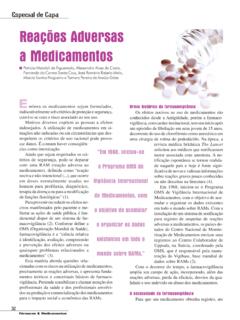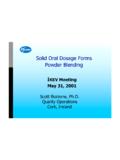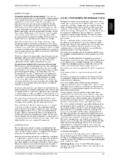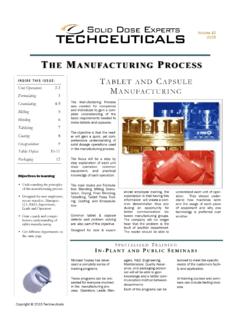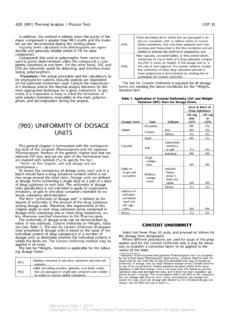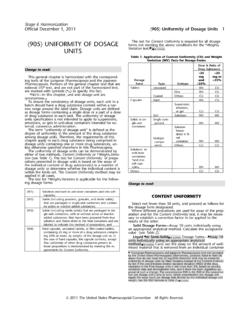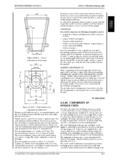Transcription of SOLID DOSAGE FORMS POWDERS AND GRANULES T
1 SOLID DOSAGE FORMS : POWDERS AND. GRANULES . o understand the advantages and potentials of controlled release T DOSAGE FORMS , it would be beneficial to learn the conventional dos- age FORMS . Conventional SOLID DOSAGE FORMS include POWDERS , GRANULES , capsules, and tablets. Drugs (which are chemicals) are in gen- eral more stable in SOLID state than in liquid state. For this reason, poorly stable drugs are usually prepared in SOLID DOSAGE FORMS . In this chapter, we will examine two SOLID DOSAGE FORMS , POWDERS and GRANULES . I. POWDERS . powder is a mixture of finely divided drugs and/or chemicals in dry form . POWDERS can be used internally and externally ( , external applications to the skin). Dry POWDERS , however, can be taken orally by some patients who are unable to swallow other SOLID DOSAGE FORMS such as capsules and tablets.
2 Although POWDERS per se are not used extensively in therapeutics, they are widely used in preparation of various DOSAGE FORMS . Powdered drugs can be blended with other powdered materials prior to fabrication into other SOLID DOSAGE FORMS . Powdered drugs are frequently added to other ingredient to make ointments, pastes, suppositories, and others. powder properties relevant to pharmaceutical formulations are single- particle properties, bulk properties, particle particle interactions, powder morphology (particle size, specific surface area, porosity, and particle shape), and mixing and blending properties (mechanisms of mixing, types of mixing equipment, and minimizing segregation tendencies). It is also important for preparing powder formulation to understand hoppers and powder transfer methods, mechanisms of particle-size reduction, and types of mills.
3 A. PARTICLE SIZES. The particle size of POWDERS is standardized according to the USP descrip- tive terms, such as, very fine, fine, moderately coarse, coarse, and very coarse. The definition of the terms for POWDERS of vegetable and animal drugs (Table ) is different from that of POWDERS of chemicals (Table ). In some countries, powdered vegetables, plants, and animal drugs are still widely used. Their main application, however, is to extract drug compounds. Leaves or plants which have bioactive compounds can be prepared in powder FORMS for extraction of the compounds. Animal pan- creas may be prepared into powder to extract insulin. 23. 24 Chapter 2 SOLID DOSAGE FORMS : POWDERS and GRANULES Table Definitions of POWDERS of Vegetable and Animal Drugs Designation Maximum Diameter Requirements Very Fine 180 m ( mm) (passes through a No.)
4 80 sieve). Fine 250 m ( mm) (passes through a No. 60 sieve). Moderately Coarse 425 m ( mm) (passes through a No. 40 sieve). Coarse 850 m ( mm) (passes through a No. 20 sieve). Very coarse 2360 m ( mm) (passes through a No. 8 sieve). Table Definitions of POWDERS of Chemicals Designation Maximum Diameter Requirements Very Fine 125 m ( mm) (passes through a No. 120 sieve). Fine 180 m ( mm) (passes through a No. 80 sieve). Moderately coarse 425 m ( mm) (passes through a No. 40 sieve). Coarse 850 m ( mm) (passes through a No. 20 sieve). * There is no Very Coarse category. B. FACTORS AFFECTED BY PARTICLE SIZE. Particle size can affect a number of factors important to DOSAGE form preparation as well as applications. They are dissolution rate, suspendabil- ity, uniform distribution, penetrability, and nongrittiness.
5 The dissolution rate of particles is dependent on the particle size. The smaller the particle size, the faster is the dissolution. In suspension prepa- ration, it is important to have a good suspendability ( , ability to main- tain uniform dispersion in liquid vehicle) of particles. In a powder mix- ture or capsule and tablets preparation, the ability of a drug to have uni- form distribution is essential. For intrarespiratory applications, the pene- trability of inhaled particles to reach a desired location within the respira- tory tract is important for deep deposition in the respiratory tract. The size range of 1 5 m is widely used. In dermal ointments, creams, and oph- thalmic preparations, nongritty fine POWDERS should be used. Fine parti- cles of 50 100 m in size can be used for this purpose.
6 C. PARTICLE-SIZE ANALYSIS. The particle size and the size distribution can be measured by a number of methods. 1. Sieving Sieving is the simplest and probably the most commonly used method for determining the particle-size distribution. A powder mass is placed on top of a sifter (mechanical shaker) that is made of a series of screens with se- quentially smaller apertures. The horizontal sieve motion loosens the packing of particles allowing subsieve particles to pass through. Most widely used screens are woven-wire screens ranging in size start- ing from 400 openings per inch. In the United States, Tyler standard and US standard (ASTM E11-70) are commonly used. The two standards are different slightly, but can be used interchangeably. POWDERS 25. Table Mesh Conversion Table ASTM Sieve No.
7 Sieve opening (mesh/inch) (mm). 400 38. 325 45. 270 53. 230 63. 200 75. 170 90. 140 106. 120 125. 100 150. 80 180. 70 212. 60 250. 50 300. 45 355. 40 425. 35 500. 30 600. 25 710. 20 850. 8 2,360. 2. Microscopy Particle size is measured using a calibrated grid background. The micro- scopic images of particles can be forwarded to a computer and the size and size distribution can be analyzed by an image analyzer. The resolution limit by light microscopy is m. Electron microscopy can be highly useful for the particles smaller than m. 3. Sedimentation Rate The terminal settling velocity of particles through a liquid medium in a gravitational and centrifugal environment can be used to calculate the par- ticle size based on Stokes' law, which is: 2. dx d ( s 0)g dt = 18 0. where dx/dt is the rate of settling in cm/s, d is the diameter of the particle in cm, s is the density of the particles (g/cm3), 0 is the density of the me- dium (g/cm3), g is the acceleration due to gravity (981 cm/s2), and 0 is the viscosity of the medium in poise (g/(cm s)).
8 (This was covered in IPPH. 362: Suspension.). 4. Coulter Counter Coulter counter determines the volume distribution of particles suspended in an electrolyte-containing solution. When a particle passes through a small orifice, it blocks the electric current. The information on particle volume is used for calculating particle size assuming a spherical shape. 26 Chapter 2 SOLID DOSAGE FORMS : POWDERS and GRANULES 5. Light Scattering Other automatic particle-size measuring instrument employs the light scat- tering principle. This can be performed either in solution or in the dry powder state. 6. Gas Adsorption The surface area of powdered materials can be measured by adsorption of solute from solution or of a gas. This method results in the specific sur- face area (area/unit mass).
9 Usually, an inert gas, such as nitrogen, is ad- sorbed as a monolayer and the total volume of gas adsorbed is used to cal- culate the specific surface area, which in turn provides information on the particle size. D. DISADVANTAGES OF THE powder DOSAGE form . POWDERS have several disadvantages as a DOSAGE form as described below: 1. Patient may misunderstand the correct method of use. Without clear instruction, patients may inhale through the nose a drug intended for oral administration. In oral administration, it may have to be clear whether the drug has to be dissolved first in water or taken as is. 2. It is undesirable to take bitter or unpleasant tasting drugs by oral ad- ministration. Many herbal drugs (mainly infusions in boiling water). have very bitter tastes. To overcome the unpleasant taste of the ex- tracts, it was often told that bitter medicine is better medicine.
10 This may not necessarily be true. 3. It is difficult to protect POWDERS containing hygroscopic, deliquescent (tending to melt or dissolve in humid environment), or aromatic mate- rials from decomposition. 4. Uniform, individually wrapped doses of POWDERS (sachets) are required and this may increase the manufacturing expense. (It is possible to in- clude a spoon in a packet of powder drug. This may result in inaccu- rate amount of drug delivered). 5. powder must be a homogeneous blend of all of the components and must be of the most advantageous particle size. The particle size of a drug influences the rate of solubility in water. It may also influence the biological activity of a drug. II. GRANULES . GRANULES are agglomerates of powdered materials prepared into larger, free flowing particles.
